_______________
Additional Photos
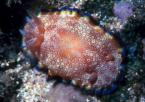
top

side

front
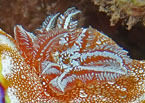
branchia

rhinophores
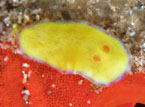
young
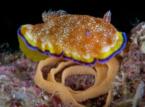
with egg mass

|
Goniobranchus albopunctatus (Garrett, 1879)
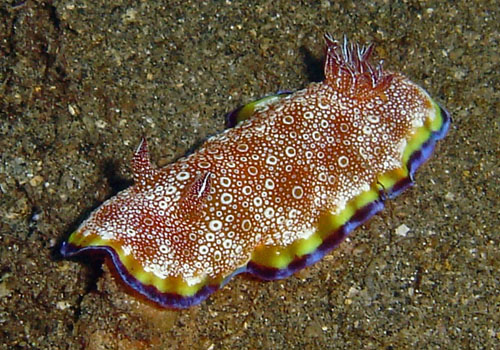
Maximum size: about 65 mm
(Kay & Young, 1969).
Identification:
This
species
has an oval body and a low profile, with a mantle that
completely overhangs the sides of the body and the foot. The dorsum
ranges from red to yellow with numerous small, white spots and ocelli.
The mantle is margined in yellow, dark blue and light blue although in some
animals the dark and light blue are reversed in order. The foot is bright yellow
or yellow-orange.
Natural history: On Maui, Goniobranchus albopunctatus
is a rare species found on rocky bottoms. However, recently it appears
to have become more common on the Big Island. It occurs in highly
protected
to
moderately protected locations (sometimes under silty conditions)
at depths of 2-20 m (6-65 ft). It's diurnally active. A 39 mm animal
laid a peach-colored egg mass 20 mm in diameter with 3 1/2 whorls.
Distribution:
Big Island, Maui, Molokai, Oahu, Kauai and Niihau: widely distributed in the Indo-Pacific.
Taxonomic notes:
This
species
was listed as Chromodoris imperialis
(Pease, 1860) in Kay, 1979 as well as Kay & Young, 1969. It was also listed as Chromodoris
cf. imperialis (Pease, 1860)
in Bertsch and Johnson, 1981. It was named
for the white spots covering the notum. It's listed as Chromodoris albopunctata (corrected in 2019 printing) and referred
to as the "white-spotted nudibranch" in Hoover, 1998 & 2006. It was
first recorded in Hawaii from Ala Moana, Oahu in Dec., 1964 (Kay &
Young, 1969). The earlier attribution to Pease in Kay, 1979 applies to Hypselodoris imperialis, instead.
Photo: PF: St. Anthony wreck, off Kihei, Maui; May 29, 2013.
Observations and comments:
Note
1: ( )
|
|








